On this page
AmphibiansThis page lists a selection of books about the frogs, toads and newts of Great Britain and Ireland. A number of general books about amphibians are also included.The books are arranged by publication date with the most recent at the top.
|
|
|
|
Field Guide to the Amphibians and Reptiles of Britain and EuropeJeroen Speybroek, Wouter Beukema, Bobby Bok, Jan Van der Voort
Illustrations: Ilian Velikov
British Wildlife Field Guides
Bloomsbury
2016
"The taxonomy and systematics of European reptiles and amphibians have changed a lot in recent years, yet there is no modern, up-to-date field guide available that comprehensively covers all the species. The last illustrated field guide to European reptiles and amphibians was first published 38 years ago, and remains oudated despite occasional reprints and new editions. This major new field guide addresses this deficiency. Every species will be covered in detail with a focus on identification and geographical variation; species texts also cover distribution, habitat and behaviour. A detailed up-to-date map is also included for each species. Superb colour illustrations by talented artist Ilian Velikov depict every species and all major variations, and colour photographs are also included for most species. This groundbreaking new guide will become the definitive field reference for these two groups of animals."
|
Buy from amazon.co.uk 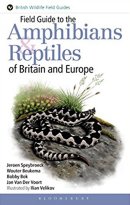
|
|
The Amphibians & Reptiles of ScotlandChris McInerny and Pete Minting
Glasgow Natural History Society
2016
This book can be downloaded from the Glasgow Natural History Society website.
"This book is designed to be an interesting and informative guide to the amphibians and reptiles that are found in the wild in Scotland. We have focused on those species native to Scotland, plus those which are non-native but are breeding in the wild. In addition to the native leatherback sea turtle, which migrates regularly to Scottish waters to feed, we have included three vagrant sea turtle species that occasionally drift here on oceanic currents."
|
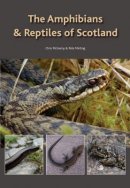 |
|
Cold Blood: Adventures with Reptiles and AmphibiansRichard Kerridge
Vintage
2015
"Part natural-history guide to these animals, part passionate nature writing, and part personal story, Cold Blood is an original and perceptive memoir about our relationship with nature. Through close observation, it shows how even the suburbs can seem wild when we get close to these thrilling, weird and uncanny animals."
|
Buy from amazon.co.uk 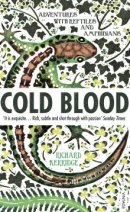
|
|
Amphibian Survey and Monitoring HandbookJohn W. Wilkinson
Conservation Handbooks
Pelagic Publishing
2015
"This book is designed to help you carry out amphibian surveying and monitoring so that the results of your surveys can be used effectively. Part 1 introduces amphibians: order Anura (frogs and toads); Caudata (newts and salamanders); and order Gymnophonia (caecilians). Part 2 is essential reading before you start surveying. It introduces the different types of survey and monitoring programmes and discusses survey aims and resources. It contains chapters on collecting and handling survey data; survey permissions and licensing; health and safety, and biosecurity; and handling amphibians. Part 3 discusses everything you need to know during your survey, and provides a detailed look at amphibian survey methods. Part 4 covers presenting and using your survey's data to best effect. A useful resources section is also provided, with example survey forms and details of additional information resources that will optimize the impacts of your surveys. Key amphibian survey techniques are discussed with reference to published examples of successful surveys - so you'll be able to choose what's right for your situation."
|
Buy from amazon.co.uk 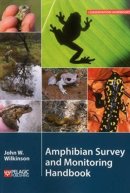
|
|
Amphibian Evolution: The Life of Early Land VertebratesRainer R Schoch
Topics in Paleobiology
Wiley-Blackwell
2014
"This book focuses on the first vertebrates to conquer land and their long journey to become fully independent from the water. It traces the origin of tetrapod features and tries to explain how and why they transformed into organs that permit life on land. Although the major frame of the topic lies in the past 370 million years and necessarily deals with many fossils, it is far from restricted to paleontology. The aim is to achieve a comprehensive picture of amphibian evolution. It focuses on major questions in current paleobiology: how diverse were the early tetrapods? In which environments did they live, and how did they come to be preserved? What do we know about the soft body of extinct amphibians, and what does that tell us about the evolution of crucial organs during the transition to land? How did early amphibians develop and grow, and which were the major factors of their evolution?"
|
Buy from amazon.co.uk 
|
|
Amphibians and ReptilesTrevor BeeBee
Naturalists' Handbooks Volume 31
Pelagic Publishing
2013
"Amphibians and Reptiles is a comprehensive guide to the native and non-native species of amphibian and reptile found in the British Isles. Professor Trevor Beebee covers the biology, ecology, conservation and identification of the British herpetofauna, and provides keys for the identification of adult and immature newts and newt eggs, larvae and metamorphs; frog and toad adults and metamorphs, spawn and larvae; adult and hatchling limbed lizards; and adult snakes. Distribution maps are included for all species, and Amphibians and Reptiles is illustrated throughout with colour photographs and figures."
|
Buy from amazon.co.uk 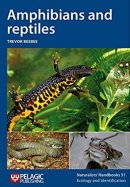
|
|
FrogCharlotte Sleigh
Animal series
Reaktion Books
2012
"Charlotte Sleigh's witty, readable Frog provides an entertaining and sometimes shocking account of this much-loved, and much-misunderstood animal. Sleigh provides answers to many questions, including why frogs have been so prominent in science throughout the years and just what place the frog holds in religion. The many faces of the frog are also explored, such as the devilish and comic; the sophisticated and chauvinist; the revolting and delicious. The author weaves the natural history of the frog together with their mythology in a way that has not been done before. Featuring many fine images of frogs from nature and culture, Frog will appeal to a wide audience - from those who keep these remarkable amphibians in their homes, to those who recall stories from their childhood with affection, to those who regard them as a tasty dinner."
|
Buy from amazon.co.uk 
|
|
Amphibian Habitat Management HandbookJohn Baker, Trevor Beebee, John Buckley, Tony Gent and David Orchard
Amphibian and Reptile Conservation Trust
2011
"This handbook forms a resource for a range of users including conservation professionals and interested volunteers. It covers those amphibians native to Great Britain such as the two that are subject to Biodiversity Action Plans (Great Crested Newt and Common Toad) and features a section on the unique ecological requirements of the Natterjack Toad - a species considered rare in the UK."
|
 |
|
The Crested Newt: A Dwindling Pond DwellerRobert Jehle, Burkhard Thiesmeier and Jim Foster
Laurenti Verlag
2011
"This book draws together research and observations on the six species of crested newt across their range. It examines their taxonomy, biology, ecology and behaviour. Incorporating the latest research, the book also contains sections of special relevance to the great crested newt in the UK, with a focus on conservation and management."
|
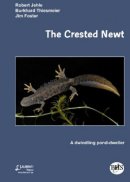 |
|
An Examination Of Reptile And Amphibian Populations In Gardens, The Factors Influencing Garden Use And The Role Of A 'Citizen Science' Approach For Monitoring Their Populations Within This HabitatElizabeth Humphreys, Mike Toms, Stuart Newson, John Baker and Kathy Wormald
BTO Research Report 572
British Trust for Ornithology
2011
"This report considers the factors that might influence garden use by reptile and amphibian species, before going on to make recommendations for management options within individual gardens. Data from the 'Reptiles and Amphibians in your Garden Survey' (RAGS) are used to examine those factors influencing garden use, including those present within individual gardens as well as in the wider landscape which surrounds them . This report also examines the potential value of data collected through the BTO Garden BirdWatch for monitoring long-term trends in garden use by reptile and amphibian species."
|
 |
|
Britain's Reptiles and AmphibiansHoward Inns
WildGuides
2009
"This detailed guide to the reptiles and amphibians of Britain, Ireland and the Channel Islands has been produced with the aim of inspiring an increased level of interest in these exciting and fascinating animals. It is designed to help anyone who finds a lizard, snake, turtle, tortoise, terrapin, frog, toad or newt to identify it with confidence. The book features: Stunning photography. An easy-to-use approach to identification. Superbly illustrated introductory sections on the biology and conservation, taxonomy, life-cycle and behaviour of each species group. Profiles of the 16 native reptiles and amphibians that breed in Britain, Ireland and the Channel Islands and the 5 marine turtles that visit our seas. Profiles of 7 established non-native species and a summary of 8 more with a history of release/escape. Distribution maps based on the latest available information."
|
Buy from amazon.co.uk 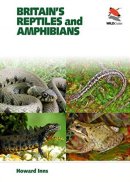
|
|
Amphibian Ecology and Conservation: A Handbook of TechniquesEditor: C. Kenneth Dodd Jr.
Techniques in Ecology & Conservation
Oxford University Press
2009
"This practical manual of amphibian ecology and conservation brings together a distinguished, international group of amphibian researchers to provide a state-of-the-art review of the many new and exciting techniques used to study amphibians and to track their conservation status and population trends. The integration of ecology and conservation is a natural outcome of the types of questions posed by these disciplines: how amphibians can and should be sampled, marked, and followed through time; how abundance and population trends are measured; what are the robust statistical methods that can be used in ecology and conservation; what roles do amphibians play in community structure and function; how do animals function in their environment; and what affects the long-term persistence of species assemblages? Although emphasizing field ecology, sections on physiological ecology, genetics, landscape ecology, and disease analysis are also included. The book describes the latest statistical approaches in amphibian field ecology and conservation, as well as the use of models in interpreting field research. Much of this information is scattered in the scientific literature or not readily available, and the intention is to provide an affordable, comprehensive synthesis for use by graduate students, researchers, and practising conservationists worldwide."
|
Buy from amazon.co.uk 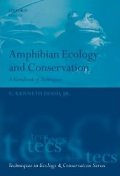
|
|
Atlas of the Amphibians of Cheshire and WirralJonathan Guest and Andy Harmer
2006
|
Buy from amazon.co.uk 
|
|
Sillocks, Skarfies and Selkies: The Fish, Amphibians, Reptiles, Birds and Mammals of OrkneyChris Booth and Jean Booth
Orcadian
2005
"Does it occur in Orkney? Is it rare? When and where can it be seen? The purpose of this book is to try, if possible, to answer some of these questions, attempting to produce a complete list of Orkney's vertebrate fauna, together with illustrations, details and where applicable, their traditional Orcadian name."
|
Buy from amazon.co.uk 
|
|
Wildlife Friendly Plants: Make Your Garden a Haven for Beneficial Insects, Amphibians and BirdsRosemary Creeser
Collins
2004
"Wildlife-friendly Plants has been specially designed to help you chose the best plants to encourage and support diminishing populations of wildlife, whether your garden is big or small, in the town or country. Many of these plants are perfect for use in small spaces, such as a patio, terrace or window box. With the valuable suggestions for use, planting and aftercare covered in this book you too can create a haven for beneficial insects, amphibians and birds, irrespective of the size or location of your garden."
|
Buy from amazon.co.uk 
|
|
Guide to the Reptiles and Amphibians of Britain and Ireland
Occasional Publication Volume 55
Field Studies Council
2nd edition
2003
An 8 page fold-out chart that covers the non-marine reptiles and amphibians found in Britain and Ireland.
|
 |
|
Reptiles and Amphibians: Britain and EuropeNicholas Arnold, Denys Ovenden
Collins
2002
"This book contains descriptions of every species of salamander, newt, frog, tree frog, toad, tortoise, turtle, terrapin, gecko, agama, lizard, chameleon, slow worm, skink, amphisbaenian and snake found in mainland Europe. Every species and distinct subspecies is described in detail, with notes on its range, size, colour and markings, diagnostic characters, habitat, behaviour and, in the case of venomous snakes, the type and virulence of its poison. The final part of the book deals with the identification of the eggs and tadpoles of frogs, toads, newts and salamanders. There are also introductions to each group of animals, with helpful keys to aid identification where necessary, an introduction to the biology of reptiles and amphibians and how best to study this fascinating part of our fauna."
|
Buy from amazon.co.uk 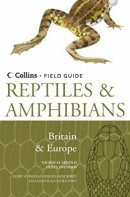
|
|
Great Crested Newt: Conservation HandbookT. Langton, C. Beckett and J. Foster
FrogLife
2001
|
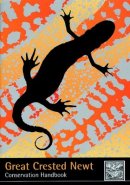 |
|
Amphibians and ReptilesTrevor Beebee and Richard Griffiths
Cover art: Robert Gillmor
New Naturalist 87
Collins
2000
"Building on the solid foundations established by the two earlier New Naturalist volumes on this subject, eminent herpetologists Trevor Beebee and Richard Griffiths have brought together a wealth of new and fascinating information on the British amphibians and reptiles. An introductory chapter looks at the subject of biogeography and how factors such as geological history, latitude and climate affect ecology, life histories and behaviour. The authors then go on to discuss historical interest in amphibians and reptiles, from how they have featured in witchcraft and legends to modern perspectives. A third chapter covers basic biology of amphibians and reptiles, before each of the main groups – newts, frogs and toads, lizards, snakes and chelonians – are examined in further detail. A comprehensive account for each species covers behaviour, life history, reproduction and distribution, as well as ecology and conservation status, areas in which significant discoveries have been made in recent years. There is also a chapter with important new information on the burgeoning number of introduced species in Britain, such as bullfrogs, alpine newts and wall lizards."
|
Buy from amazon.co.uk 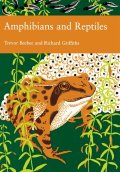
|
|
Tadpoles: The Biology of Anuran LarvaeRoy W. McDiarmid and Ronald Altig
University of Chicago Press
1999
"In this reference, experts on tadpole biology relate what is known about tadpoles and what one might learn from them in the future. The book provides summaries of tadpole morphology, development, behaviour, ecology and environmental physiology; explores the evolutionary consequences of the tadpole stage; synthesizes available information on their biodiversity; and presents a standardized terminology and a literature review of tadpole biology."
|
Buy from amazon.co.uk 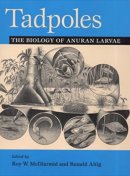
|
|
A Natural History of AmphibiansRobert C Stebbins and Nathan W Cohen
Princeton University Press
1997
"Robert Stebbins and Nathan Cohen lead readers on a fascinating odyssey as they explore some of nature's most interesting creatures, interspersing their own observations throughout the book. A Natural History of Amphibians can serve as a textbook for students and independent learners, as an overview of the field for professional scientists and land managers, and as an engaging introduction for general readers. The class Amphibia contains more than 4,500 known living species. New species are being discovered so rapidly that the number may grow to more than 5,000 during our lifetimes. However, their numbers are being rapidly decimated around the globe, largely due to the encroachment of humans on amphibian habitats and from growing human-caused environmental pollution, discussed at length in the final chapter. The authors focus our attention on the "natural history" of amphibians worldwide and emphasize their interactions with their environments over time: where they live; how they reproduce; how they have been affected by evolutionary processes; what factors will determine their destinies over time."
|
Buy from amazon.co.uk 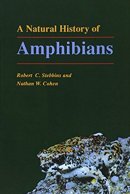
|
|
Frogs and ToadsTrevor Beebee
British Natural History Series
Whittet Books
1997
|
Buy from amazon.co.uk 
|
|
The Newts and Salamanders of EuropeRichard Griffiths
Poyser Natural History
Poyser
1996 (reprint 2002)
"Nearly thirty years after the publication of the last detailed book on the newts and salamanders of Europe, this book at last provides a much needed, modern coverage of the ecology, behaviour, evolution and conservation of these fascinating amphibians. It shows how the diversity of newt and salamander life-styles underlines how this relatively small group of animals has managed to survive in such diverse habitats as underground caves, mountain tops, tropical forests and the Siberian tundra. The species accounts are accompanied by notes and maps on distribution, habitat requirements and behaviour, as well as colour photographs of every species."
|
Buy from amazon.co.uk 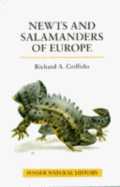
|
|
Biology of AmphibiansWilliam E. Duellman and Linda Trueb
Johns Hopkins University Press
New paperback edition
1994
"This is the widely acclaimed, preeminent reference and text on all aspects of amphibian biology, including their life history, ecology, morphology, and evolution. Copiously illustrated with original drawings and photographs and meticulously referenced with more than 2,500 bibliographic entries, it has proved indispensable to professional biologists and students alike."
|
Buy from amazon.co.uk 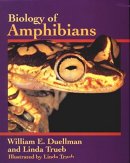
|
|
Mammals, Reptiles and Amphibians of Britain and EuropePaul Morrison
Macmillan
1994
"Including over 500 photographs of animals in their natural habitats, this book combines information on mammals, reptiles and amphibians. The text not only allows the reader to locate and identify species in the wild, but offers a fascinating insight into the private lives of animals which are typically secretive, and often nocturnal."
|
Buy from amazon.co.uk 
|
|
The Common ToadFred Slater
Shire Natural History 60
1992
"The common toad is in evolutionary terms an ancient creature and has variously been the subject of hate, curiosity, superstition and legend. It is an animal that generally goes unseen except by the diligent garener or in spring, when it is drawn back to its traditional spawning pond. These breeding migrations have brought the species to the attention of the general public because of the number which are regrettably killed by vehicles as they cross major roads. Although much is known about the migrations and the subsequent aquatic phases of the toad's life history, far less is known about the cues and controls of migration or about the terrestrial part of the toad's year.This book draws together the scattered strands of information to provide a fascinating account of this unusual animal."
|
Buy from amazon.co.uk 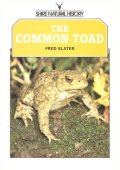
|
|
The Book Of The ToadRobert M. DeGraaff
Lutterworth Press
1991
"This comprehensive and entertaining compendium of toad lore surveys the history of the toad as biological entity, literary and artistic subject, mythological symbol, and threatened species. It brings to light a number of unexpected details regarding the life of the toad, ranging from its role as insect eater in gardens and pharmaceutical ingredient in shamanic hallucinogens, to its time honoured place in witchcraft and its apotheosis in stars as the constellation Bufo. Robert DeGraaff's offbeat history is exhaustively researched, scientifically precise, graced with high colour art reproductions and illustrations, and written with uncommon wit and humour. Far more than a volume for bufophiles, this is a uniquely insightful and engaging look at how humans through the ages have responded to and have been influenced by their amphibian neighbours."
|
Buy from amazon.co.uk 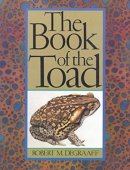
|
|
Newts of the British IslesPatrick J. Wisniewski
Shire Natural History 47
1989
|
Buy from amazon.co.uk 
|
|
Reptiles and Amphibians in BritainDeryk Frazer
Collins
New Naturalist 69
1983
"Dr Frazer describes all those species of reptiles and amphibians native to Britain and others, once alien to our islands, which have been introduced. He makes use of the latest field discoveries, his own accumulated research and that of many other distinguished herpetologies, to present a detailed picture of reptile and amphibian ecology in Britain. An introductory first chapter deals with anatomy and physiology of herptiles and their evolution, ending with a brief look at the way in which their ecology may be studied. Succeeding chapters each give details of particular families and their species: frogs and toads, newts, lizards, snakes and chelonians. A final chapter discusses conservation of herptiles in Britain, especially of those species which are in danger."
|
Buy from amazon.co.uk 
|
|
Reptiles and Amphibians of Britain and EuropeE.N. Arnold, J.A. Burton, D.W Ovenden
Collins
1978
"A guide which contains descriptions of every species of reptile and amphibian found in mainland Europe, together with introductions to each group of animals and information on the biology of reptiles and amphibians."
|
Buy from amazon.co.uk 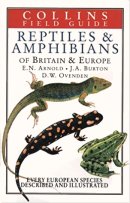
|
|
The British Amphibians and ReptilesM. Smith
Collins
The New Naturalist 20
1951
"This book fills an obvious gap in the literature of British natural history. Very many years have passed since a work of any kind has been published on our amphibians and reptiles, and indeed no other book at all has been written that deals with every known aspect of their structure and behaviour. Dr. Smith has been collecting his material for a third of a lifetime, during which he has become the acknowledged authority on the herpetology, not only of Britain but of Western Europe. His association with the British Museum and his years of expeditions and field observations have made him into as happy combination of ecological naturalist and museum man – and surely he is the best kind of naturalist who knows his way about the fields, woods and streams, as well as he knows his way about the intricacies of description, measurement and bibliography."
|
Buy from amazon.co.uk 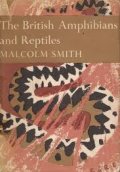
|
|